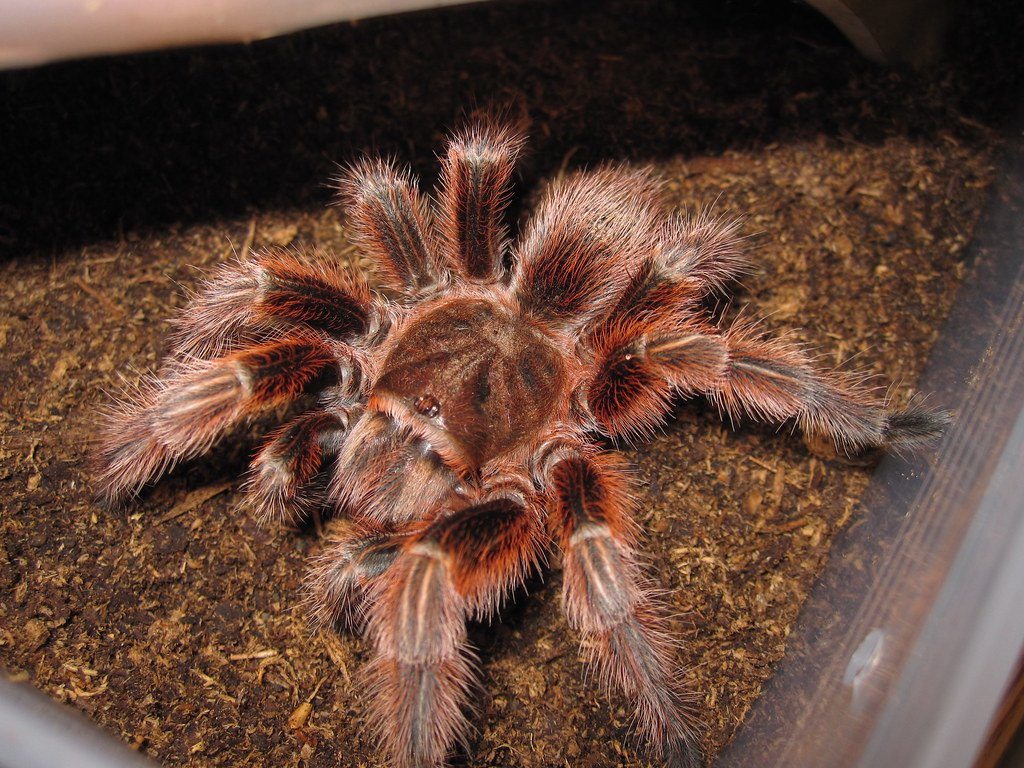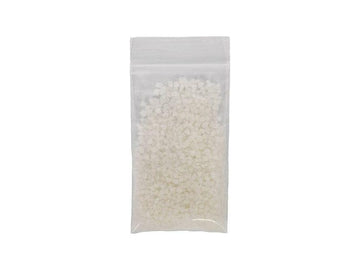Chilean rosehair tarantulas (Grammostola rosea) are 5” diameter, nocturnal, terrestrial tarantulas native to Chile, Argentina, and Bolivia. They prefer to live in dry grasslands and shrublands.
Chilean rosehair tarantulas are fairly traditional tarantulas in shape. They have medium-brown bodies and may or may not have a pinkish head. They have urticating hairs, which are generally reddish to blond in color.
Chilean rosehair tarantulas make good pets because of their gentle, tolerant nature and slow movement. When cared for properly, males generally live up to 5 years, and females can live 20+ years.
Minimum terrarium size for Chilean rosehair tarantulas
The minimum terrarium size for a Chilean rosehair tarantula varies depending on its size. Slings can be housed in basic acrylic spiderling enclosures, no smaller than four legspans by three legspans. These should be gradually upgraded until they are large enough to be comfortable in an adult-sized enclosure no smaller than 20”L x 10”W x 10”H, or a 10 gallon tank, although taller (and larger in general) is better.
Using a lid on top of the enclosure is required, but beware of using traditional mesh lids, as tarantula feet easily get stuck in them, potentially leading to injury. If you want to use mesh, make sure the gaps are large enough to prevent entrapment. Alternatively, replace the screen with a sheet of acrylic with small holes drilled into it for ventilation.
Housing multiple tarantulas in the same terrarium is not recommended, and is likely to result in cannibalism if attempted.
Do Chilean rosehair tarantulas need UVB?
Chilean rosehair tarantulas are generally kept without UVB lighting, as they have proven to be capable of surviving without it, and considering that UVB wavelengths are blocked by glass and acrylic, installing the lamp can be tricky.
However, there is some evidence to suggest that tarantulas may benefit from UVB lighting when appropriately provided. This paper speculates that wild tarantulas may get at least part of their vitamin D3 from UVB exposure, and this paper provides evidence of invertebrates being able to synthesize vitamin D3 from UVB.
If you want to provide UVB for your tarantula, the best bulb to use will be a compact coil Zoo Med Reptisun 5.0 26w, mounted horizontally in a reflective fixture. Place this lamp on top of a mesh lid with holes large enough to prevent the spider from getting its feet caught, so you may want to wait to provide UVB lighting until the tarantula has grown large enough for an adult enclosure. UVB output decays with age, so the bulb must be replaced every 6 months to maintain performance.
Lights should be on for 12 hours/day.
Best temperature for Chilean rosehair tarantulas
Chilean rosehair tarantulas should be kept around 74°F. This is a little warmer than room temperature, so if you need to boost your temps, use a small heat mat stuck to the side of the enclosure and connected to a thermostat set to 80-82°F to create a temperature gradient. Use a digital probe thermometer to keep track of enclosure temperatures.
Best humidity levels for Chilean rosehair tarantulas
Chilean rosehair tarantulas prefer moderate humidity levels between 40-55%. For slings and juveniles, this can be done by slightly moistening the substrate. For adults, it’s best to simply to provide both dry and moist areas in the enclosure. When moistening the substrate, make it slightly damp, not saturated. Measure the ambient humidity levels with a digital probe hygrometer.
Best substrate for Chilean rosehair tarantulas
Although Chilean rosehair tarantulas are not commonly known to burrow in captivity, they are known to burrow in the wild, so it’s still a good idea to offer them that choice. Slings should have around 1-2” of substrate, and adults should have at least 4”.
We recommend the following substrates for Chilean rosehair tarantulas:
- Zoo Med Eco Earth
- Zoo Med ReptiSoil
- Exo Terra Plantation Soil
How to decorate a Chilean rosehair tarantula terrarium
An empty terrarium can lead to a stressed tarantula, and it’s not much to look at, either. At bare minimum, you will need at least one hiding spot for the tarantula to use. However, you can also include other decorative items, such as:
- small logs and branches
- cork flats
- live or artificial plants
- artificial ornaments
What to feed to a Chilean rosehair tarantula
Chilean rosehair tarantulas are primarily insectivores, which means that they need to eat a variety of insects to get the right nutrition. Slings should be fed every 4-7 days, juveniles should be fed every 7-10 days, and adults should receive a meal every 2-3 weeks.
Offer 1-5 appropriately-sized insects per feeding, depending on the tarantula’s body condition and the size of the insect. Each insect should be small enough for the tarantula to easily overpower, especially for slings, which is roughly the same length as its abdomen.
Feeder insect options: crickets, dubia roaches, discoid roaches, red runner roaches, black soldier fly larvae, mealworms
Flightless fruit flies are a good option for particularly small slings.
Uneaten prey should be removed 24 hours after offering.
Water
Of course, don’t forget a small water bowl for your tarantula to drink from! If it’s too small for a water bowl (under 2” diameter), then mist the enclosure occasionally to create water droplets for it to drink. Change the water dish daily and scrub it out with a reptile-safe disinfectant weekly.
How to handle your Chilean rosehair tarantula
Tarantulas don’t appreciate petting and handling in the same way that dogs and cats do. That being said, Chilean rosehair tarantulas tend to tolerate human interaction fairly well. They rarely bite or even shoot hairs. Simply allow your tarantula to crawl onto your hand, and keep your movements slow. Handle them over a soft surface, like a bed or couch, to cushion them in case they fall. Handling should not be done frequently, however.
*This care sheet contains only very basic information. Although it’s a good introduction, please further your research with high-quality sources. The more you know, the better you will be able to care for your pet!
"Grammostola rosea 'red phase' tarantula adult" by Tarantuland is licensed under CC BY-NC 2.0











